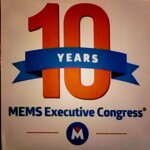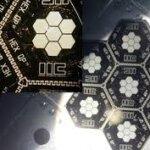If you are anyone doing anything important, or wanting to know anything important about MEMS and Sensors, then you were probably at the MEMS Industry Group (MIG)’s MEMS Executive Congress US 2014, from November 5-7, in Scottsdale, AZ.
(Or else you were in Phoenix for the NASCAR race, which is why I couldn’t get the Avis car I had reserved. But that’s a different story.)
The MEMS Executive Congress 2014 showed how and why the micro-electromechanical systems (MEMS) /sensors industry is spearheading new user experiences in consumer, environmental, healthcare/medical, and industrial applications, among others. And there was a fair bit of heterogeneous integration content threaded through many, if not most, of the talks and discussions over the day and a half of the conference.
 It’s been ten years now of MECs!
It’s been ten years now of MECs!
Karen Lightman, Executive Director, MEMS Industry Group, offered this note on the evolution of MIG and MEMS Executive Congress. “Ten years ago, MIG had 57 members and 95 attendees at MEMS Executive Congress. Today we have over 170 members and partners, and 250 attendees.”
Success! And holding the Congress in Scottsdale rather than in a Novembery Pittsburgh, PA, was just the ticket for this Pittsburgher.
A great new feature of the MEMS Executive Congress has been the Elevator Pitch Session. In this year’s edition, the “Shark Tank”-like event featured seven finalists representing a mixture of startups, established companies, researchers, and individuals who pitched their hearts out ten minutes at a time to a panel of distinguished judges. (That’s you, Ken Aitchison, president and CEO, Applied Microstructures; you, Roger Grace, president, Roger Grace Associates; you, Thomas Licata, investment banking representative, materials scientist, Livingston Securities; and you, John Trotter, managing director, Brockson Capital Advisors.)
This year’s Elevator Pitch winner was Indiana Integrated Circuits LLC, whose Quilt Packaging (QP) concept is a new microchip interconnection technology that incorporates conductive “nodules” fabricated on the sides of chips.
Why Quilt Packaging? In his successful pitch to the judges, Jason Kulick, president and co-founder of IIC, offered these differentiating features for the QP technology:
- QP is composed of chip-to-chip edge connections joined to create a multi-chip “quilt”
- QP quilts can be disparate materials & process technologies
- QP performs as if it were an on-chip interconnect
- QP makes 2D and 3D assemblies possible
- QP takes advantage of industry-standard fab processes & tooling
New technology is only as good as its value proposition; to that end, Jason said that QP has these benefits:
- QP enables heterogeneous integration
- QP enables economic partitioning of device functions
- QP allows for modular device design & test
In terms of supply chain readiness, Jason said that Quilt Packaging is currently being implemented in such diverse application spaces as infrared imaging, microwave/RF applications, satellite imaging, and more.
QP is currently offered in scalable volumes at RTI International today, where customers are performing QP fabrication, using industry standard processes similar to TSV-middle, MEMS-like etching & metallization.
I was reminded in the Arizona setting, of how the Native American agricultural technique of planting Three Sisters (squash, maize, and beans) together, in a kind of heterogeneous integration, resulted in fabulous synergy: “The three crops benefit from each other. The maize provides a structure for the beans to climb, eliminating the need for poles. The beans provide the nitrogen to the soil that the other plants utilize, and the squash spreads along the ground, blocking the sunlight, helping prevent establishment of weeds. The squash leaves also act as a ‘living mulch’, creating a microclimate to retain moisture in the soil, and the prickly hairs of the vine deter pests. Maize lacks the amino acids lysine and tryptophan, which the human body needs to make proteins and niacin, but beans contain both and therefore maize and beans together provide a balanced diet.”
 What gains will we experience from our own Three Sisters – the integration of silicon transistors, silicon MEMS, and compound semiconductor photonics, for example? What kind of sturdy quilt can we make from them? It should be good.
What gains will we experience from our own Three Sisters – the integration of silicon transistors, silicon MEMS, and compound semiconductor photonics, for example? What kind of sturdy quilt can we make from them? It should be good.
I’ll have more to say about heterogeneous integration at the MEMS Executive Congress in my next post; in the meantime, congratulations to Indiana Integrated Circuits and to Jason Kulick, who were awarded a $150K iGrant from Rogue Valley Microdevices and Sustainable Valley Technology Group, plus one free year of MIG membership, for the successful pitch. May continued commercial success for IIC and for heterogenous integration to follow.
From Pittsburgh, PA, thanks for reading. ~ PFW





![[err-ad-fallback-title]](http://www.3dincites.com/wp-content/plugins/a3-lazy-load/assets/images/lazy_placeholder.gif)

















